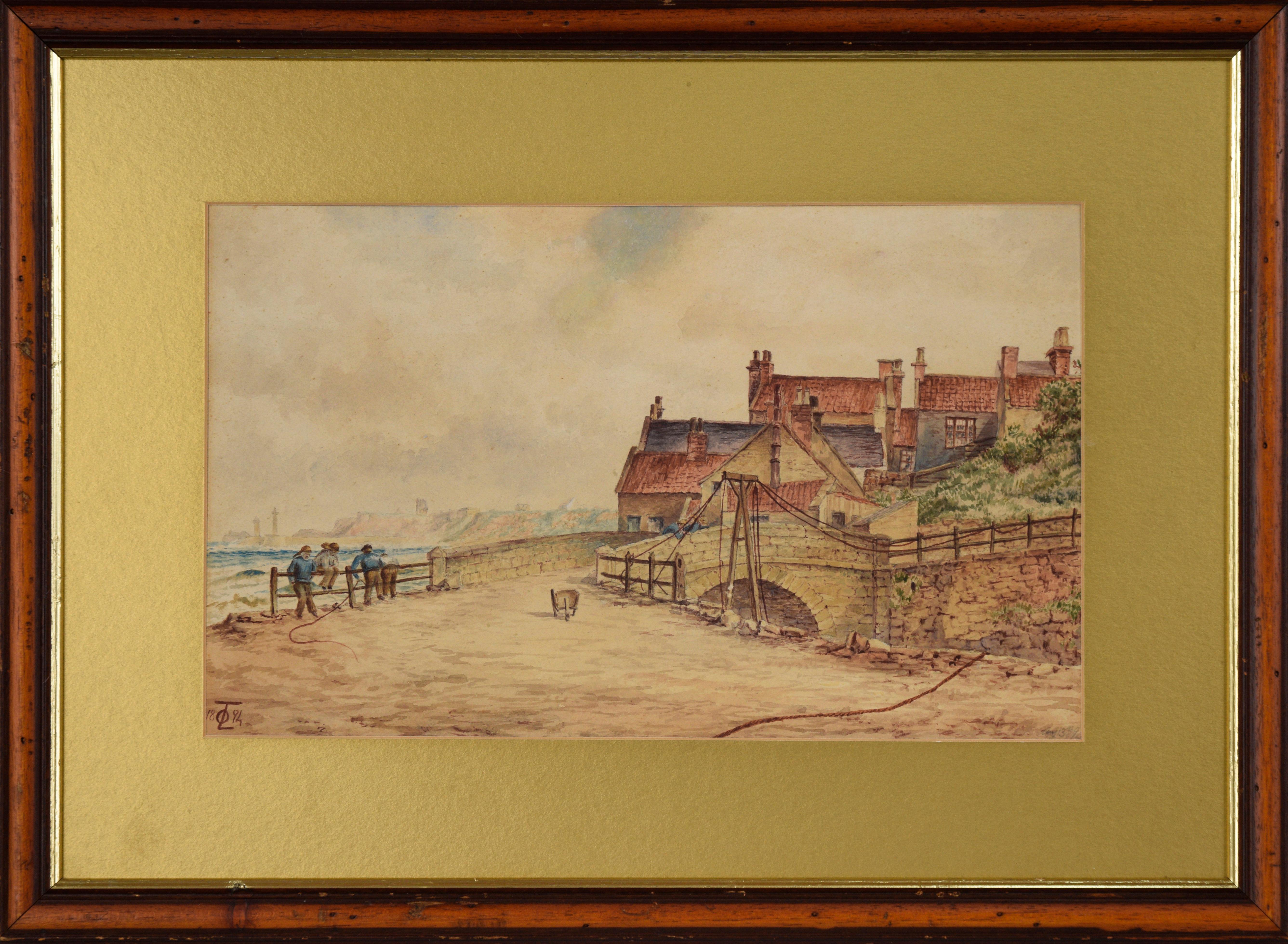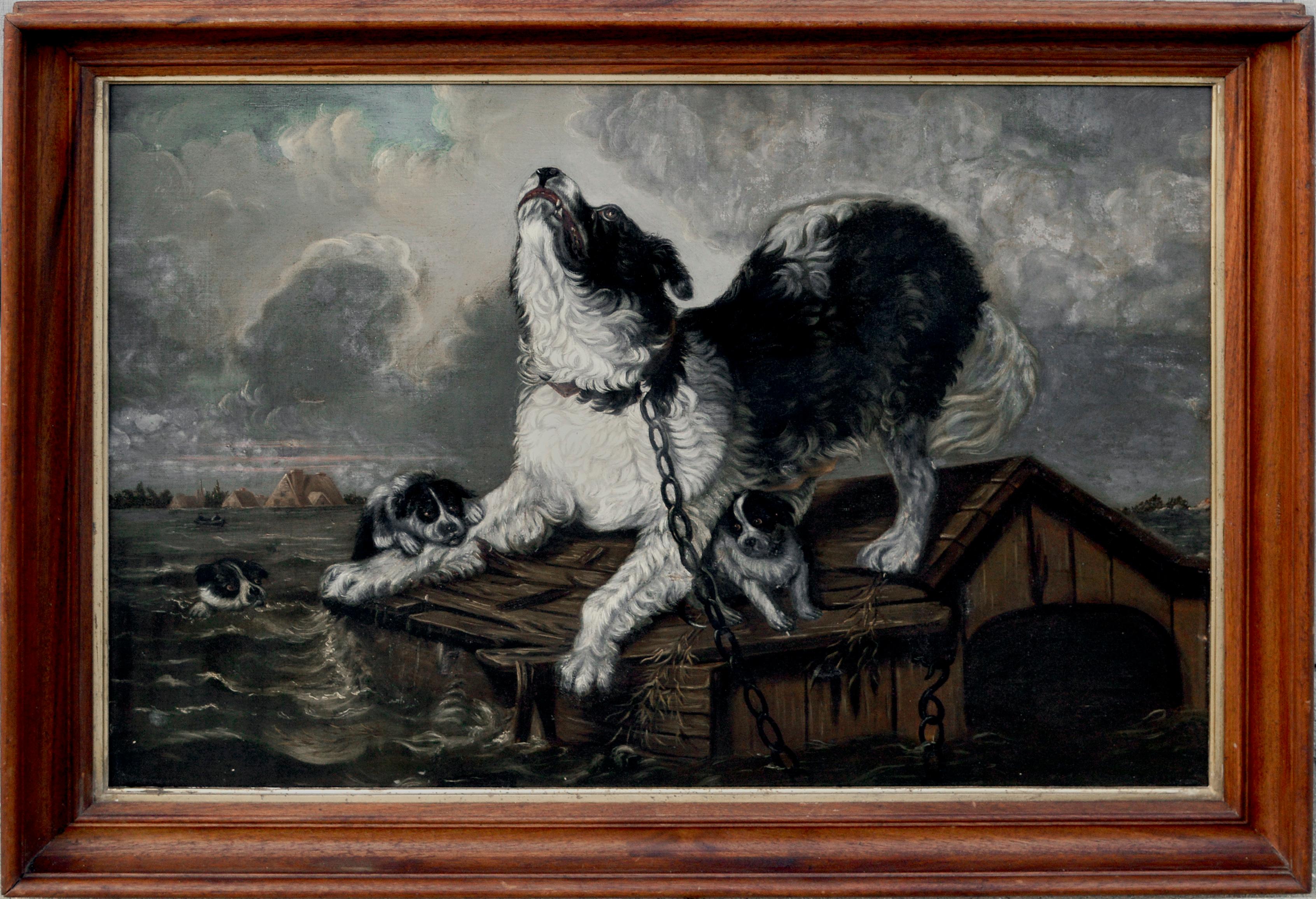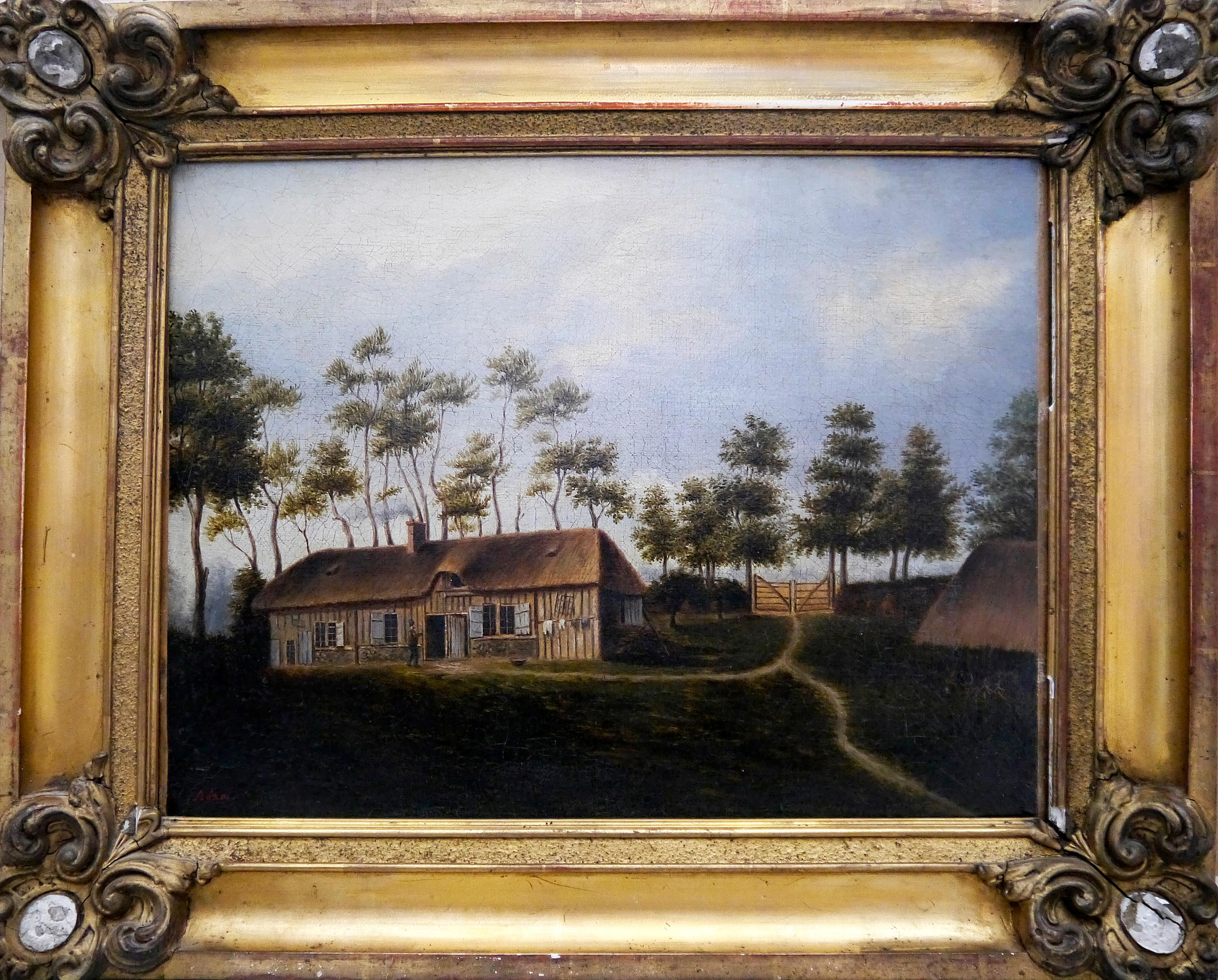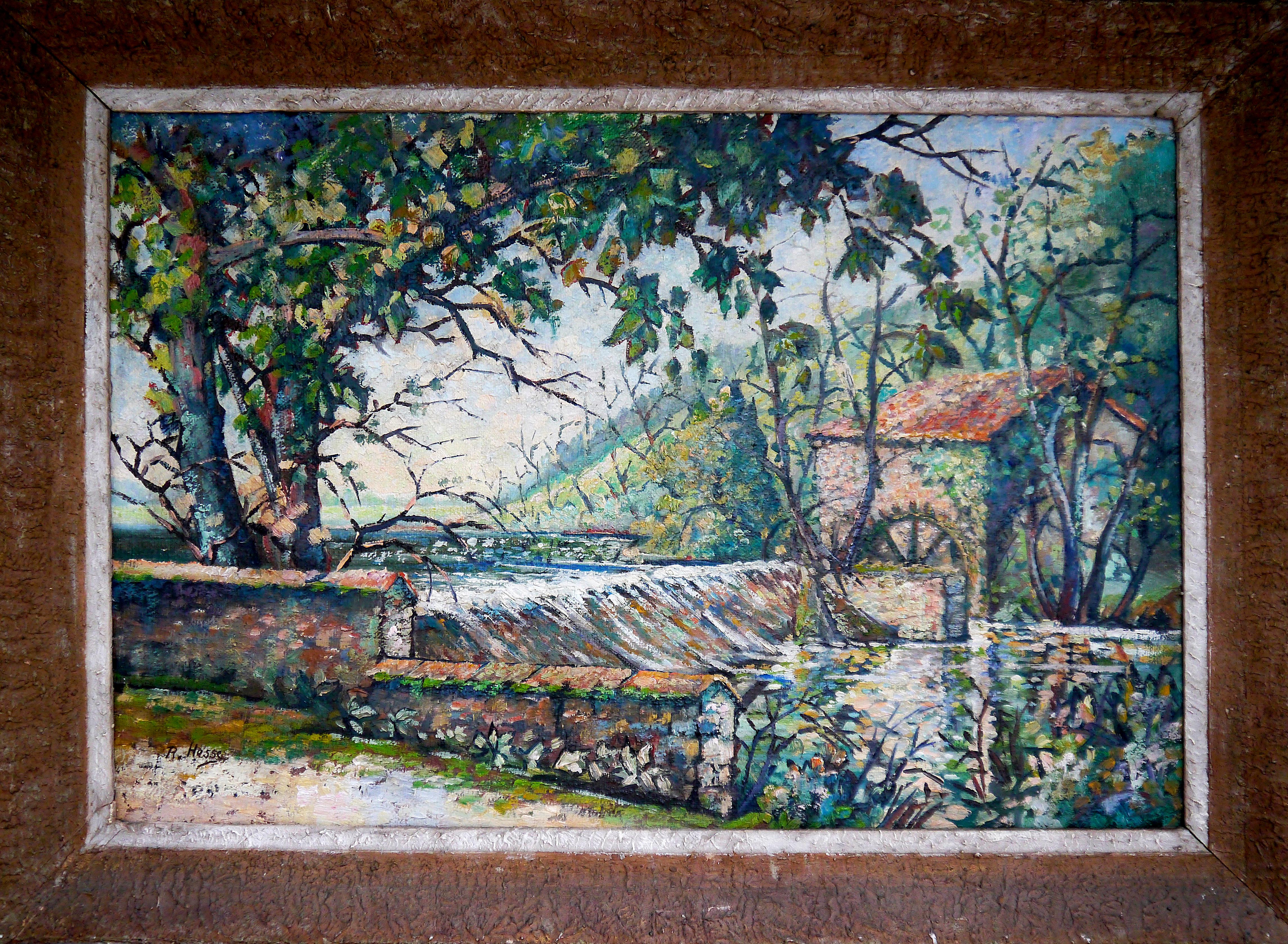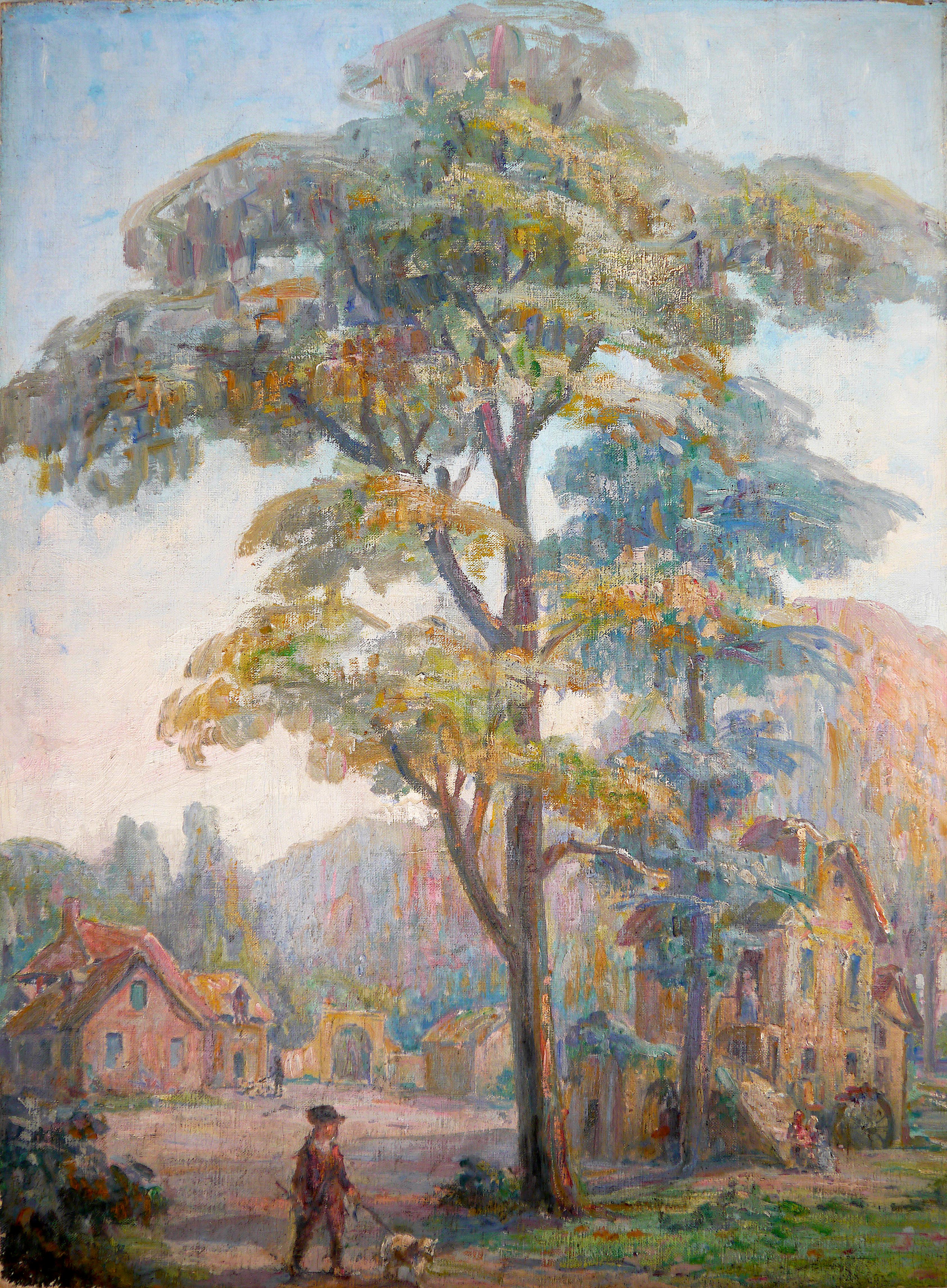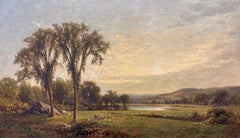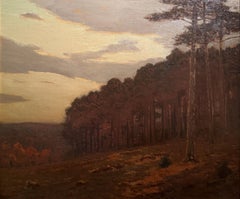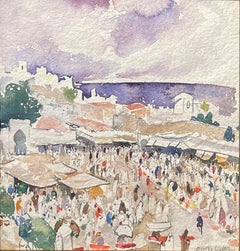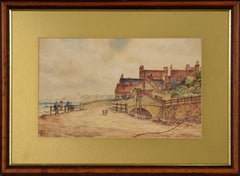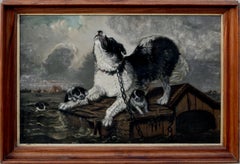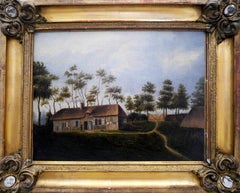Items Similar to "Western Wilderness Interior" William Keith, California Tonalist, Woods Clearing
Want more images or videos?
Request additional images or videos from the seller
1 of 14
William Keith"Western Wilderness Interior" William Keith, California Tonalist, Woods Clearing
$6,500
£4,991.72
€5,720.45
CA$9,150.39
A$10,250.46
CHF 5,331.51
MX$125,034.51
NOK 67,877.28
SEK 64,003.43
DKK 42,695.87
About the Item
William Keith
Western Wilderness Interior
Signed lower left
Watercolor on paper laid on artist board
14 1/2 x 19 inches
A native of Scotland, William Keith became in the late 19th and early 20th centuries a leading Northern-California landscape artist. In fact, he was so well known that he is referred to as the "Dean of California painters." His romanticized views of nature found much favor among the culturally aspiring citizens of San Francisco and hung in many foyers and dining rooms in their elegant homes. He completed thousands of paintings and drawings, and many of them were lost in his studio in the fire of 1906.
His early works are dramatic mountainscapes in a realistic style adopted from the Dusseldorf School of Germany. The paintings of the last two decades of his life are looser and obviously influenced by his exposure in France to the Barbizon School of landscape painters, who were the first colony of painters to complete paintings "en plein air," or directly from nature rather than in studios. A forerunner of Impressionism, this style also included Tonalism espoused by Barbizon painter Camille Corot [1796-1875] and also apparent in Keith's later works, which are darker, smaller, and much more intimate with emphasis on mood.
Born in Aberdeenshire, Scotland, Keith came to New York with his family and, apprenticed to a wood engraver. In 1859, he moved to San Francisco where he worked for an engraver and later set up his own engraving business. Studying with Samuel Marsden Brookes in 1863, he determined to become a painter.
He married artist Elizabeth Emerson and did watercolor painting with her guidance. In 1868, he became a full-time painter, and that same year was commissioned to paint scenes along the Columbia River including Mount Hood. By August 1869 he had sold enough paintings to finance an extended journey to the East Coast and Europe including Dusseldorf, Germany throughout most of 1870, studying with Albert Flamm. After a visit to Paris, he expressed great admiration for "the modern school of French landscape painting including the Barbizon School.
During the winter of 1871-1872, the Keiths lived in Boston where they shared a studio with William Hahn. Keith's work received critical acclaim there and in New York at the National Academy of Design.
In 1872, he returned to San Francisco. A friendship with naturalist John Muir exposed Keith to many remote places and in-depth knowledge of nature. During the 1870s, he painted several "epic" eight by ten-foot High Sierra views. He also visited Alaska, and his paintings of Alaska were exhibited upon his return to San Francisco in a show at the Bohemian Club, titled 'Dreams of Alaska'. Keith's Alaska works are significant because they are not close transcriptions of actual scenery, but rather are fantasies inspired by Alaska. They are important as they represent a major break from the documentary tradition in landscape painting of Alaska, as they show an interest in capturing its spirit versus just the topography.
The first wife of William Keith died in 1882, and in 1883, he married Mary McHenry, the first woman graduate of Hastings Law School. They soon went to Europe, and Keith studied portrait painting in Munich with consultations from J. Frank Currier and Carl Marr for two years. Keith then settled for the remainder of his life in Berkeley, California, at 2207 Atherton Street. His studio was in San Francisco where he commuted daily, painted prolifically, and taught many classes, mostly for aspiring female artists .
In 1891, he shared his studio for several weeks with East Coast Tonalist George Inness, Sr. [1825-1894]. Both men painted in a similar style and were followers of the mystical teachings of Swedenborg. Among the locations where Inness and Keith painted together were Monterey and Yosemite, and it was reported they discussed art from every possible angle. Under Inness' influence, Keith painted more than ever in a Barbizon-influenced vein with many sunset and twilight scenes.
By the early 1900s, Keith was likely one of the wealthiest artists in the United States and certainly earned the most money of any California-based artist. People from all over the world sought out his studio where it was said that he would specially select a painting for a client from behind a black velvet curtain, order everyone to be quiet, part the curtains, and set the work on a easel, flooded in light. It was unthinkable not to buy a painting on these occasions. Many of his paintings were shown in New York at the Macbeth Gallery, and in 1898, he had a special exhibition in New York.
Keith died April 13, 1911, and his work is in most of the institutions representing major California artists. Saint Mary's College in Moraga, California has a collection of Keith paintings established by his biographer, Brother Cornelius.
- Creator:William Keith (1838-1911, American)
- Dimensions:Height: 22.5 in (57.15 cm)Width: 28.5 in (72.39 cm)
- More Editions & Sizes:Unique workPrice: $6,500
- Medium:
- Movement & Style:
- Period:
- Condition:
- Gallery Location:New York, NY
- Reference Number:1stDibs: LU1841216731042
About the Seller
5.0
Platinum Seller
Premium sellers with a 4.7+ rating and 24-hour response times
Established in 2022
1stDibs seller since 2022
115 sales on 1stDibs
Typical response time: <1 hour
- ShippingRetrieving quote...Shipping from: New York, NY
- Return Policy
Authenticity Guarantee
In the unlikely event there’s an issue with an item’s authenticity, contact us within 1 year for a full refund. DetailsMoney-Back Guarantee
If your item is not as described, is damaged in transit, or does not arrive, contact us within 7 days for a full refund. Details24-Hour Cancellation
You have a 24-hour grace period in which to reconsider your purchase, with no questions asked.Vetted Professional Sellers
Our world-class sellers must adhere to strict standards for service and quality, maintaining the integrity of our listings.Price-Match Guarantee
If you find that a seller listed the same item for a lower price elsewhere, we’ll match it.Trusted Global Delivery
Our best-in-class carrier network provides specialized shipping options worldwide, including custom delivery.More From This Seller
View All"Farmland Meadows" George Henry Smillie, Hudson River School, Sunset Landscape
By George Henry Smillie
Located in New York, NY
George Henry Smillie
Farmland Meadows, 1865
Signed and dated lower left
Oil on canvas
10 1/2 x 18 inches
Provenance
Private Collection, Langley, Washington
The career of George Sm...
Category
1860s Tonalist Figurative Paintings
Materials
Canvas, Oil
"Autumn, New England" Charles Warren Eaton, Tonalist Gloaming Sunset in Woods
By Charles Warren Eaton
Located in New York, NY
Charles Warren Eaton
Autumn, New England
Signed lower right
Oil on canvas
30 x 36 inches
Provenance
Private Collection, Connecticut
A contemporary critic wrote that the paintings o...
Category
Early 1900s Tonalist Figurative Paintings
Materials
Canvas, Oil
"Market Scene, North Africa" Martha Walter, Female Impressionist Scene of Market
By Martha Walter
Located in New York, NY
Martha Walter
Market Scene, North Africa
Signed lower right
Watercolor on paper
9 x 9 inches
Martha Walter was best known as a painter of colorful beach scenes and landscapes. Infl...
Category
Early 20th Century Impressionist Figurative Paintings
Materials
Paper, Watercolor
"China Town" Ernest Fiene, 1925 Modernist Watercolor on Paper Chinatown Scene
By Ernest Fiene
Located in New York, NY
Ernest Fiene
China Town, 1925
Signed and dated to lower right ‘Ernest Fiene 1925’.
Watercolor on paper
18 1/2 x 14 5/8 inches
Ernest Fiene was born in Elberfeld, Germany in 1894. As a teenager, Fiene immigrated to the United States in 1912. He studied art at the National Academy of Design in New York City from 1914 to 1918, taking day classes with Thomas Maynard and evening classes with Leon Kroll. Fiene continued his studies at the Beaux-Arts Institute of Design in New York from 1916 to 1918, adding classes in printmaking at the Art Students League in 1923.
Fiene began his career as an artist in 1919 with his first exhibition of watercolors at the MacDowell Club arranged by his mentor Robert Henri. In 1923 the Whitney Studio Club mounted a large exhibition of his works. The following year he had an exhibition at the New Gallery in New York, which completely sold out all fifty-two works, including paintings, watercolors, drawings, and etchings. With the proceeds of sales from the New Gallery exhibition, Ernest Fiene and his younger brother Paul, a sculptor, built studios in Woodstock, New York in 1925.
In the early Twenties Ernest Fiene painted mostly landscapes of Woodstock and both the Ramapo and Hudson River Valleys. The first monograph from the Younger Artists Series was published on Fiene in 1922. Published in Woodstock, the series went on to include Alexander Brook, Peggy Bacon, and Yasuo Kuniyoshi. The book reproduced 1 illustration in color and another 27 reproductions in black and white. Around 1925 Fiene became fascinated with the intensity, excitement, and opportunities for color harmonies New York City offered as a subject. His paintings shifted to urban and industrial themes with architecture, industry, and transportation becoming his subjects.
By 1926 Fiene had attracted the dealer Frank K.M. Rehn, who gave him a one-man exhibition that year, which travelled to the Boston Arts Club. C.W. Kraushaar Galleries gave Fiene a one-man exhibition of urban, landscape, portrait, and still life paintings in 1927. Julianna Force, the director of the Whitney Studio Club and first director of the Whitney Museum of American Art, included two of Fiene’s paintings in a fall exhibition in 1928. The Whitney Studio Club showed Fiene’s paintings in a two-man exhibition with Glenn O. Coleman that year and acquired three of Fiene’s paintings. Also in 1928 Fiene became affiliated with Edith Halpert’s Downtown Gallery where he had an exhibition of 20 lithographs in the spring. Fiene sold his house in Woodstock in 1928 to spend more of his time in New York City.
With so many successful exhibitions, Fiene returned to Paris in 1928-29 where he rented Jules Pascin's studio and studied at the Académie de la Grande Chaumière. In France, Fiene painted both landscape and urban subjects developed from ideas influenced by Cubist geometry and the use of flat areas of broad color. Upon returning to New York in 1930, Fiene used this new approach to continue to paint New York skyscraper and waterfront subjects, as well as to begin a series of paintings on changing old New York based on the excavations for Radio City Music Hall and the construction of the Empire State Building. Frank K.M. Rehn Galleries exhibited this series, titled “Changing Old New York,” in 1931. Fiene also has solo exhibitions at Rehn Galleries in 1930 and 1932. Fiene’s oil paintings are exhibited at the Chicago Arts Club in 1930 as well.
Fiene was included in the Museum of Modern Art’s exhibition Painting and Sculpture by Living Americans in December of 1931. Visiting New York, Henri Matisse saw the exhibition and called Fiene’s Razing Buildings, West 49th Street the finest painting he had seen in New York. Fiene had two mural studies from his Mechanical Progress series exhibited at the Museum of Modern Art’s exhibition Murals by American Painters and Photographers in 1932. Fiene sent View from my Window which depicts Fiene working on a lithograph stone while looking out his window to the newly completed Empire State Building to the Carnegie International in 1931. In 1932 Fiene participated in the first Biennial of American Painting at the Whitney Museum and his prints were included in exhibitions at the Downtown Gallery and the Wehye Gallery. In the same year, Fiene was awarded a Guggenheim fellowship to further study mural painting in Florence, Italy.
On his return from Italy in 1933 Fiene re-engaged himself in New York City life and won several public and private mural projects. Fiene resumed his active exhibition schedule, participating in two group exhibitions at the Whitney Museum and a one-man exhibition of recent paintings at the Downtown Gallery in January 1934. In 1933 he purchased a farm in Southbury, Connecticut, which added Connecticut scenes to his landscape subjects. This was also the year Fiene began to spend summers on Monhegan Island, Maine, where he painted seascapes, harbor scenes, and still lifes.
Fiene’s landscape paintings attracted numerous commissions as part of the American Scene movement. Through the fall and winter of 1935-36, Fiene took an extended sketching trip through the urban, industrial, and farming areas of Pennsylvania and West Virginia. Most of the twenty-four Pennsylvania urban and rural paintings from this trip were featured in an exhibition held at the First National Bank in Pittsburgh in October of 1937 by the Pittsburgh Commission for Industrial Expansion. Fiene said of these works that he formed rhythm, opportunity for space and color, and integrity in the Pennsylvania mill and furnace paintings. Fiene received the silver medal for one of the Pittsburgh paintings...
Category
1920s Modern Figurative Paintings
Materials
Paper, Watercolor
"Corbett House, Monhegan Island, Maine" Jamie Wyeth, 1973 Maine Watercolor
By Jamie Wyeth
Located in New York, NY
Jamie Wyeth
Corbett House, Monhegan Island, Maine, 1973
Signed lower left
Watercolor on paper
20 3/4 x 28 1/2 inches
The house depicted in the present work is on Monhegan Island, Ma...
Category
1970s Realist Figurative Paintings
Materials
Watercolor, Paper
"Forest Landscape" John F. Carlson, circa 1925 American Impressionist Landscape
By John F. Carlson
Located in New York, NY
John F. Carlson
Forest Landscape, circa 1925
Signed lower right
Watercolor on paper
Sight 21 x 24 1/2 inches
The native Swede John Fabian Carlson became a household name in New Yor...
Category
1920s American Impressionist Landscape Paintings
Materials
Paper, Watercolor
You May Also Like
English Country Landscape - Original Painting on Paper by Oliver Louis Tweddle
Located in Soquel, CA
English Country Landscape - Watercolor on Paper
Watercolor painting depicting an American country landscape by Oliver Louis Tweddle (English, B-1860). Four fishermen stand upon a br...
Category
1890s Tonalist Landscape Paintings
Materials
Watercolor, Board, Laid Paper
"Inundation" after Carl Fredrik Kiörboe - "ÖVERSVÄMNING" Dogs During a Flood
By Carl Fredrik Kiorboe
Located in Soquel, CA
"Inundation" after Carl Fredrik Kiörrboe - Dogs During a Flood
Oil on linen painting of a family of dogs in a flood by an unknown artist, unsigned, after an engraving of the painting...
Category
Early 1900s Tonalist Figurative Paintings
Materials
Oil, Acrylic, Illustration Board
19th Century French School Landscape BARBIZON Oil painting Signed
Located in Zofingen, AG
➡️Rustic Cottage in a Woodland Clearing⬅️
☀️Subject & Setting☀️
A thatched-roof cottage sits in a clearing surrounded by dense, slender trees with soft foliage.
A winding dirt path ...
Category
Early 1800s Tonalist Landscape Paintings
Materials
Canvas, Oil, Stretcher Bars
$437 Sale Price
79% Off
French School Landscape BARBIZON Oil painting Signed
Located in Zofingen, AG
➡️Rustic Cottage in a Woodland Clearing⬅️
This painting, signed simply 'Adam,' appears to be the work of an artist closely associated with the Barbizon school—a movement that emerge...
Category
1830s Tonalist Figurative Paintings
Materials
Gesso, Canvas, Oil, Stretcher Bars
$443 Sale Price
75% Off
French School Impressionist The old watermill oil painting
Located in Zofingen, AG
➡️Vivid Landscape⬅️
⏩It is signed R Hesse, probably René Jean Hesse (1910-2000) ⏪
René Hesse was a French painter whose art captured the essence of rural Lorraine with remarkable s...
Category
Early 1900s Tonalist Figurative Paintings
Materials
Gesso, Canvas, Oil, Stretcher Bars
$886 Sale Price
79% Off
French school Medieval scene Landscape Oil painting
Located in Zofingen, AG
⭐Medieval scene from anonymous painter
⭐Structural Analysis :⭐
Medieval composition due to the tunic worn by the character (at the bottom of the painting) walking their dog. The cen...
Category
Early 1900s Tonalist Figurative Paintings
Materials
Oil, Stretcher Bars
$508 Sale Price
81% Off
